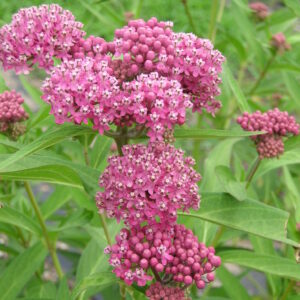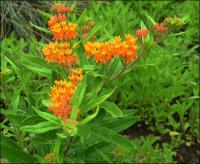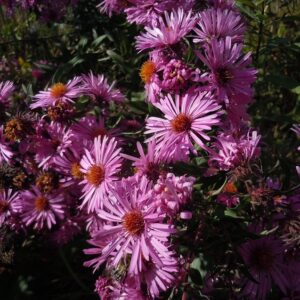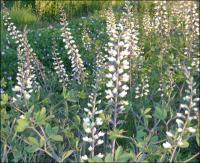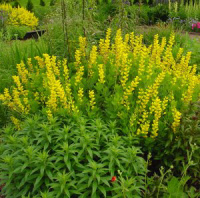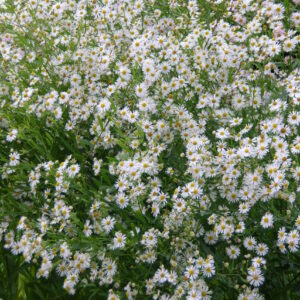Prairie Plants
Showing 9–16 of 85 results
-
Artemisia ludoviciana Silver sage, Wormwood Z 4-9
Grown for its silver-grey foliage
OUT OF STOCK
Grown for its silver-grey foliage in the garden & dried in arrangements
Size: 3’ x 2’ and spreading
Care: sun in well-drained soil
Native: Colorado south to Texas, west to California.Blackfoot cleaned themselves with this as part of religious rituals. California’s Shasta Indians prepared dead bodies to be buried with the leaves. HoChunk made a smudge to revive the unconscious. Cahuilla Indians made baskets and roofs and walls of their homes with the stems. First collected for gardens by Thomas Nuttall in early 1800’s. Artemisia named for the wife of Mausolus, king of Caria, who began using another Artemisia. Miller 1768.
-
Asclepias incarnata Swamp milkweed Z 3-9
pink umbels, like an upside down ballerina’s skirt
Fragrant medium pink umbels, like an upside down ballerina’s skirt, July – September.
Size: 3’-4’ x 2-3’
Care: Sun in moist to moist well-drained soil, deer resistant
Native: North America – all states (except along the Pacific coast) & eastern half of Canada, Wisconsin native
Wildlife Value: host for Monarch caterpillars, flowers are source of nectar for several butterfliesNamed after Asclepias, a Greek god of medicine. Native American groups used Swamp milkweed – Chippewa to increase their strength & the stems made into twine; Iroquois to heal navels in babies, to increase or decrease urine and to make a person strong enough to punish witches; Meskwaki to drive out tapeworms; and Menominee used it as an ingredient in food – added to deer soup & cornmeal mush. Listed as growing in England in Miller’s Gardeners’ Dictionary, 1768. Pressed specimen in Emily Dickinson’s herbarium.
-
Asclepias tuberosa Butterfly weed, Pleurisy-root Z 4-9
Gorgeous - July - September bright orange cymes
OUT OF STOCK
Gorgeous – July – September bright orange cymes
Size: 2-3' x 12"
Care: Sun in moist well-drained to dry soil
Native: East and south North America, Wisconsin native
Wildlife Value: Host for Monarch caterpillars and its nectar is a favorite for 13 different butterflies: 4 Swallowtails, 2 Fritillaries, Checkered white, Spring azure, Small copper, Sachem, Monarch, and Coral and Gray hairstreaks. Attracts Ladybugs that eat many insect pests.
Awards: Great Plants for Great Plains; Perennial Plant Assn. Plant of the Year 2017.Named after Asclepias, a Greek god of medicine. Omaha Indians ate the raw root to cure bronchial and pulmonary ailments, their Shell Society was the authorized guardian of the plant, taking 4 days to dig, prepare and distribute the root. Most important medicine for Menominee Indians. The Iroquois smashed roots on legs to impart strength to runners. Navajo cured coyote bites and flu with Butterfly weed. Millspaugh said used as “subtonic, diaphoretic, alternative, expectorant, diuretic, laxative, escharotic, carminative, anti-spasmodic, anti-pleuritic, stomachic, astringent, anti-rheumatic, anti-syphilitic and what not?” 1st collected by Rev. John Banister in colonial Virginia c. 1680. A gunman mistakenly shot and killed him while he collected plants. Used by natives for Bloody Flux; the Root must be powdered and given in a Spoonful of Rum, or rather as the Indians give it, bruise the Root, and boil it in Water, and drink the Decoction: Pehr Kalm saith it is excellent for the hysteric Passion.” HoChunk placed masticated root into wounds. Cultivated by Jefferson. Pressed specimen in Emily Dickinson’s herbarium.
-
Aster novae angliae syn. Symphyotrichum New England Aster Z 4-8
August – October, classic violet, pink or magenta daisies
August – October, classic violet, pink or magenta daisies
Size: 3-4' x 24"
Care: Full sun dry to moist soil. Heat and drought tolerant.
Native: Vt to Alabama, west to N. M., Wisconsin native
Wildlife Value: Nectar source for many butterflies - Checkered white and Checkered skippers, Spring azure, Pearl crescent, Buckeye, Painted lady, Fiery skip butterfly, Sachem, Sleepy orange, Silver-spotted skipper and Monarch. Host for caterpillars Wavy-lined emerald moth.Aster means star, referring to the flower’s form. For the Cherokee New England aster tea cured fevers and diarrhea. Roots remedied pain and inflammation of the nose and throat. Introduced to garden cultivation by John Tradescant the Younger (1608-1662) in 1637 when he sent it to England where upon borders of New England aster became common. Washington grew New England Aster at Mount Vernon.
-
Baptisia australis syn. Saphora australis False Indigo Z 3-9
Indigo blue racemes in June followed by ornamental black seed pods on this perennial that looks like a shrub. This is a legume that improves soil fertility by making nitrogen available to the Baptisa and surrounding plants. Internationally known garden designer Piet Oudolf’s 100 “MUST HAVE” plants, Gardens Illustrated 94 (2013).
Indigo blue racemes in June followed by ornamental black seed pods on this perennial that looks like a shrub. This is a legume that improves soil fertility by making nitrogen available to the Baptisa and surrounding plants. Internationally known garden designer Piet Oudolf’s 100 “MUST HAVE” plants, Gardens Illustrated 94 (2013).
Size: 3' x 3'
Care: Full sun sandy soil. Heat and drought tolerant, with no staking needed.
Native: Eastern United States, Wisconsin native.
Wildlife Value: Food source for several caterpillars and nectar for a number of butterflies.
Awards: Received England’s Royal Horticultural Society Award of Merit. Perennial Plant Association Plant of the Year Award, 2010. Missouri Botanic Garden Plant of MeritBaptisia is Greek meaning to dye referring to use of the plant as a substitute for indigo dye. Cherokee used Baptisia australis for a number of illnesses: cease mortification, cure toothaches and induce vomiting. Collected by John Bartram (1699-1777) plant explorer and colonial nurseryman by 1748.
-
Baptisia leucantha syn. Baptisia lacteata, Baptisia alba White Wild Indigo, Prairie wild indigo Z 3-9
Gorgeous, tall creamy white flower spikes in May & June followed by black seed pods. This is a legume that improves soil fertility by making nitrogen available to the Baptisia and surrounding plants.
Gorgeous, tall creamy white flower spikes in May & June followed by black seed pods. This is a legume that improves soil fertility by making nitrogen available to the Baptisia and surrounding plants.
Size: 3-5' x 2-3'
Care: full sun to part shade in rich well-drained soil. Drought tolerant.
Native: Wisconsin native – from Minnesota to Texas.
Wildlife Value: food source for several caterpillars and nectar and pollen for a number of butterflies and bees. Deer resistant.Winnebago (HoChunk) mashed cooked root to make a poultice applied to remedy inflammation of the womb. Meskwaki applied root to cure old sores and, made a compound to remedy wounds from a rattlesnake bite, knife or ax, an infusion to remedy dropsy, Leucantha means white flowered.
-
Baptisia sphaerocarpa Yellow wild indigo Z 5-8
Spikes of yellow pea-like flowers in spring cover this broad plant - really makes you say “awe” or “oooh” when it blooms. All season resembles a shrub Flowers turn into round seed pods the size of a marble. This is a legume that improves soil fertility by making nitrogen available to the Baptisa and surrounding plants.
Spikes of yellow pea-like flowers in spring cover this broad plant – really makes you say “awe” or “oooh” when it blooms. All season resembles a shrub Flowers turn into round seed pods the size of a marble. This is a legume that improves soil fertility by making nitrogen available to the Baptisa and surrounding plants.
Size: 3’ x 3’
Care: sun to part shade in moist well-drained to dry soil. Drought tolerant.
Native: Missouri to Mississippi to TX
Wildlife Value: food source for several caterpillars and nectar and pollen for a number of butterflies and bees pollen. Deer resistant
Awards: Missouri Botanic Garden Plant of Merit.Baptisia is Greek meaning “to dye” referring to use of Baptisia australis as a substitute for indigo dye. Sphaerocarpa means “round seed.” Collected before 1834 by Thomas Nuttall (1786-1859) English planthunter who scoured the US from the Atlantic to the Pacific.
-
Boltonia asteroides False starwort, Bolton’s aster Z 4-9
“Bloom profusely” majestic, white daisies cover imposing, cheerful plant, August – September
“Bloom profusely” majestic, white daisies cover imposing, cheerful plant, August – September
Size: 5-6' x 3'
Care: full sun to part shade in moist well-drained soil.
Native: Maine to Florida, west to Texas and north to North Dakota and all areas in between, Wisconsin
Wildlife Value: provides pollen to over 40 bee species, moths, butterflies and wasps.Named in honor of 18th century English botanist, James Bolton. Asteroides means resembling as aster. Species introduced in 1758. Recommended for fall blooms in Wisconsin State Horticultural Society Annual Report, 1911.


